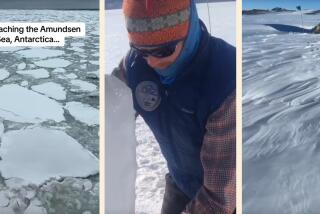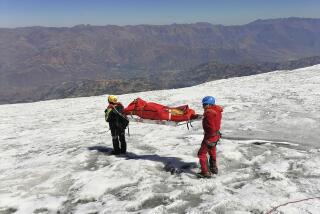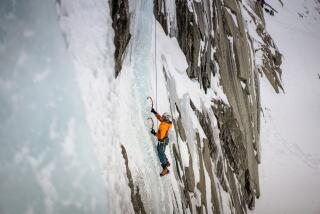Analyzing ancient ice in the tropics before it melts
PORT MORESBY, PAPUA NEW GUINEA — For 5,000 years, great tongues of ice have spread over the 3-mile-high slopes of Puncak Jaya, in the most remote reaches of this remote tropical island. Now those glaciers are melting, and Lonnie Thompson must get there before they’re gone.
To the American glaciologist, the ancient ice is a vanishing “archive” of the story of El Nino, the equatorial phenomenon driving much of the world’s climate.
More than that, the little-explored glaciers are a last unknown for a mountaineering scientist who for three decades has circled the planet pioneering the deep-drilling of ice cores, both to chronicle the history of climate and to bear witness to the death of tropical glaciers from global warming.
“No one knows how thick these remaining glaciers are,” Thompson said of Puncak Jaya, or Mount Jaya. “We do know they are disappearing.”
The unknowns on this wild, Texas-sized island extend even to the local climate.
“There are indications of warming,” said Kasis Inape, a senior government climatologist here. “But we can’t really confidently say the temperature change has been this much or that much, because the actual data are lacking.”
As a companion project to Thompson’s expedition, an international research team including Inape plans a first-ever assessment of recent climate change on New Guinea, especially along the 1,200-mile mountainous spine of the southwestern Pacific island.
Thompson’s quest on Puncak Jaya will be for something deeper in the past.
“We may actually see an El Nino history there,” he said by telephone from his office-laboratory at Ohio State University. And that history may foretell the future, he and others believe.
Knowing how past temperature changes affected El Nino, the atmospheric-oceanic disturbance that roils the tropics every few years, may help scientists predict how much worse and more frequent El Nino’s droughts, tempests and floods may grow as the world warms in decades to come.
Such discoveries would be the latest for Thompson, whose achievements were recognized by a National Medal of Science at a White House ceremony in July.
Aided by his wife and collaborator, climatologist Ellen Mosley-Thompson, Thompson’s career began in the 1970s with climbs to the glacier-draped peaks of the Peruvian Andes, where his team perfected advanced drilling techniques. By 2001, he was making headlines with his discovery that the storied snows of Kilimanjaro, the east African mountain’s glacial cap, might disappear by 2015.
On some 50 expeditions, often with U.S. National Science Foundation support, he and colleagues have braved high winds, frostbite and altitude sickness, survived in ice caves, crossed treacherous crevasses with makeshift bridges, and hauled heavy equipment to unlikely heights.
In 2006, at a 20,000-foot-high site in the Tibetan Himalayas, Thompson had to rely on dozens of yaks to carry ice-core segments on their backs to the valley below.
An accumulation of four miles of ice cores, including one Himalayan sample reaching back 750,000 years, now lies in cold storage at the lab in Columbus, Ohio, where the ice is analyzed layer by layer through centuries past.
Flecks of dust, falling seasonally, enable glaciologists to count the years down the ice core’s length. Isotopes of oxygen, in minute air bubbles trapped in the ice, vary with temperature and tell researchers how ancient climate shifted. Other clues -- chemicals, surrounding geology, trapped and frozen vegetation or insects -- tell investigators more.
Thompson’s assault on Puncak Jaya, planned for May-June 2009, will take his crew into isolated, mist-shrouded highlands seldom visited even by tribes in the area, across Papua New Guinea’s border in the Indonesian half of this island. In 2006, a biological expedition to its uncharted tropical forests reported finding new species of birds, frogs, even a tree kangaroo.
The last scientific expedition to the glaciers took place in 1973, when Australian glaciologist Ian Allison and colleagues trekked seven days through the wilderness past gushing rivers and groves of tree ferns, with gear borne by a train of tribesmen.
“In the fourth or fifth day you see in the distance the sheer limestone cliffs with the ice on top, and it’s really quite a sight,” Allison recalled by phone from Australia.
Thompson, 59, should have an easier time scaling those 10,000-foot cliffs.
The mining company Freeport-McMoRan, operating nearby, has agreed to airlift his dozen-member team to Puncak Jaya’s heights by helicopter, along with six tons of equipment.
They will find glaciers very different from those Allison saw. Although ever-present cloud cover complicates satellite surveillance, meticulous research by Texas A&M; University geographers has determined that the glaciers are rapidly shrinking.
“We’re tracking their demise by satellite images,” the university’s Andrew Klein said from College Station, Texas. “If current retreat rates continue, they will disappear in a few decades. This is similar to what’s happening to tropical glaciers around the world.”
The researchers estimate that since about 1850, as heat-trapping industrial emissions accumulated in the atmosphere, Puncak Jaya’s ice has shrunk from covering seven square miles to less than one.
Getting there soon is key, Thompson said. “Whatever history is still there, we’ll try to get it.”






